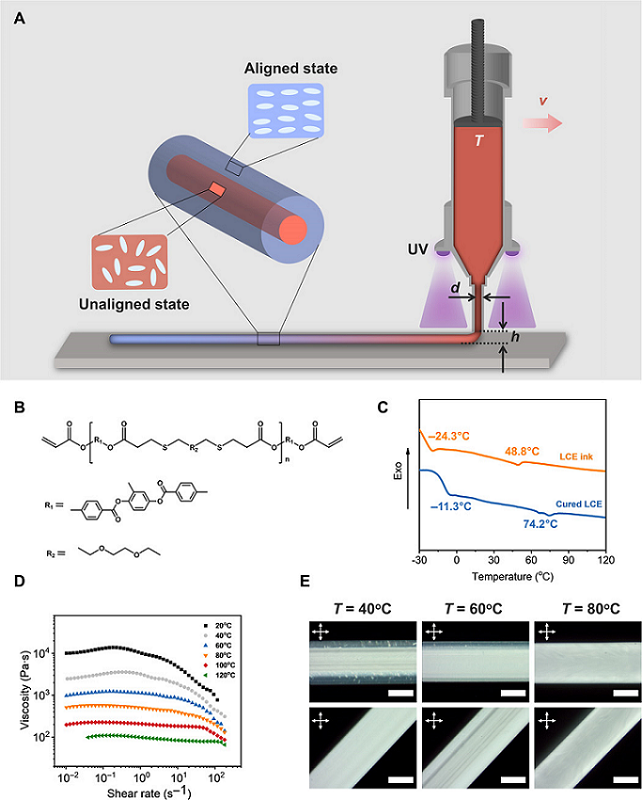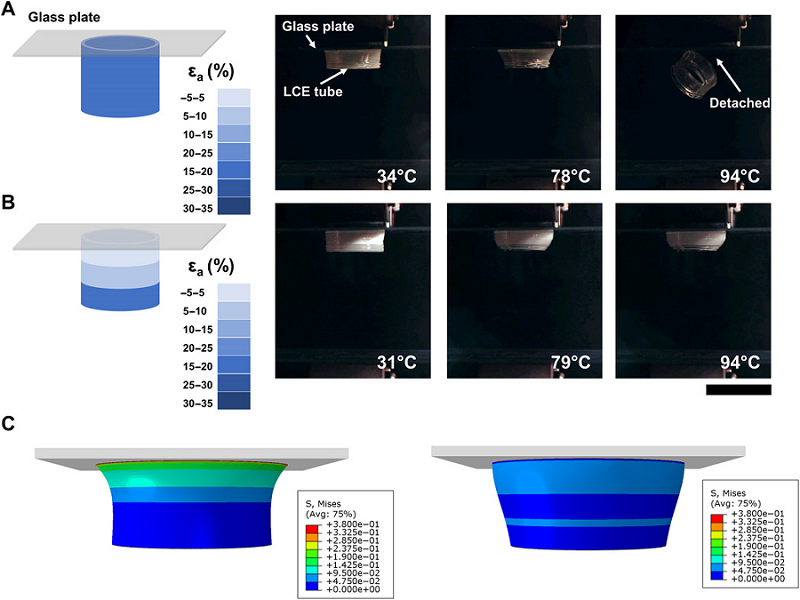A team of materials science and engineering researchers from UC San Diego (UCSD) closely studied the qualities of liquid crystal elastomers, or LCEs, in order to figure out how to make shape-shifting 3D printed structures out of the material. The results will lead to easier shape control, and manufacturing, of things like artificial muscles, soft robots, and wearable devices. Their inspiration for a material featuring varying degrees of actuation (ability to contract and degree of stiffness) came from real-life examples in the world around us, such as a squid’s beak, which is really stiff at the tip but more malleable and soft where it connects to the cephalopod’s mouth.
The team—Zijun Wang, Zhijian Wang, Yue Zheng, Qiguang He, Yang Wang, and Shengqiang Cai— published a paper about their research, titled “Three-dimensional printing of functionally graded liquid crystal elastomer,” in the journal Science Advances.

Researchers 3D printed structures made of two layers of LCE with different properties and showed that this gave the material even more degrees of freedom to actuate.
The abstract states, “As a promising actuating material, liquid crystal elastomer (LCE) has been intensively explored in building diverse active structures and devices. Recently, direct ink writing technique has been developed to print LCE structures with various geometries and actuation behaviors. Despite the advancement in printing LCE, it remains challenging to print three-dimensional (3D) LCE structures with graded properties. Here, we report a facile method to tailor both the actuation behavior and mechanical properties of printed LCE filaments by varying printing parameters. On the basis of the comprehensive processing-structure-property relationship, we propose a simple strategy to print functionally graded LCEs, which greatly increases the design space for creating active morphing structures.”
Both a core and a shell make up 3D printed LCE filament. In learning how to control its material properties, the researchers found that, post-print, the shell stiffens and cools down quickly, but it takes longer for the core to cool, so it remained pliant for longer periods of time.
Wang, the paper’s first author and a PhD student in Cai’s research group, explained, “3D-printing is a great tool to make so many different things–and it’s even better now that we can print structures that can contract and stiffen as desired under a certain stimuli, in this case, heat.”

DIW printing of LCE with tailorable thermomechanical properties. (A) Schematic of the DIW printing setup of LCE. The LCE ink is heated up to the temperature T and extruded out the nozzle with an inner diameter d. The nozzle tip moves at a speed of V during printing, and distance between the nozzle tip and build plate is h. Because of the shear stress generated through extrusion, liquid crystal mesogens are initially aligned along the print path. After a period of time, the extruded LCE filament cools down to room temperature and a core-shell structure forms inside. The outer shell cools down much faster than the inner core. As a result, well-aligned liquid crystal mesogens in the outer shell are temporarily fixed by high material viscosity, while the mesogens have enough time to reorientate to a polydomain state in the inner core. (B) Molecular structure of uncrosslinked liquid crystal oligomer in the ink. (C) DSC traces of LCE ink and cured LCE. (D) Viscosity of the ink as a function of shear rate at different temperatures. (E) Polarized optical microscope (POM) images of LCE filaments printed at different temperatures. Scale bars, 0.5 mm.
The point is, the researchers figured out that LCE’s degree of actuation could be easily controlled through the print temperature, and that by exposing the material to heat, they could also control the stiffness of various areas in the same material. So by changing print parameters, especially temperature, they were able to tune the material’s mechanical properties: the higher the temperature, the higher the flexibility of LCE.
“By controlling printing parameters, such as printing temperature, nozzle size, and distance between the nozzle and build plate, we can print LCE filaments with tailorable properties including actuation strain, actuation stress, and mechanical stiffness,” the researchers wrote.
They used direct ink writing (DIW) to print an LCE disk at 104°F, and then placed it in hot water, which heated the disk up to 194°F and shifted into a conical shape. But, the researchers found that when heating up an LCE disk that included areas printed at different temperatures, it would deform in a different shape.
Cai, a professor in the Department of Mechanical and Aerospace Engineering at the UCSD Jacobs School of Engineering, stated, “Based on the relationship between the properties of LCE filament and printing parameters, it’s easy to construct structures with graded material properties.”

3D printed LCE bilayer structures with six petals. Fluorescent dye RhB was added to the ink before printing, and photos taken under 365-nm UV illumination. (A) Each petal is composed of two layers of LCE with different print paths but the same parameters. The angle between the two paths in two layers is 90°. When the bilayer structure is immersed in hot water of 90°C, all petals twist. (B to D) The print paths of two layers of petals are the same along the length direction. Also, for the bottom layer, the LCE is printed with minimal actuation strain. For the top layer of a petal, the actuation strain is homogeneous in (B) but with customized gradient in (C) and (D). When the bilayer structures are immersed in hot water of 90°C, their bending morphologies are distinct from each other in (B) to (D). FEA simulations were used to calculate the deformed shapes of the printed bilayer structures. The stress field is represented by different colors. The gradient printing strategy increases the design space for active morphing structures. Scale bars, 20 mm.
They also printed lattice structures, and structures with two LCE layers, each with different properties, to show that the material would then have even more degrees of actuation freedom. Additionally, hot water isn’t the only thing the researchers used to activate the material’s actuation: they also infused the LCE with heat-sensitive particles, or ones that could convert absorbed light into heat, such as graphene or black ink powder.
For the proof of concept, which consisted of using one ink to print an LCE tube that had been tuned during the print process, the team demonstrated how it would adhere longer to a rigid glass plate if it had been actuated in warmer temperatures, as opposed to a tube with “homogenous properties.”
“We further demonstrate mitigation of stress concentration near the interface between an actuatable LCE tube and a rigid glass plate through gradient printing,” they wrote.
This specific finding could help improve the fabrication of robotic grippers and feet.

Demonstration of mitigating stress concentration near the interface between active LCE tube and glass plate. (A) Homogeneous LCE tube printed on rigid glass plate. When the tube is heated to 94°C, the tube detaches from the plate. (B) LCE tube with gradient properties printed on rigid glass plate. The tube stays attached to glass plate when the temperature is increased to 94°C. (C) FEA simulations of the tubes’ stress field at 94°C with homogeneous properties (L) and graded properties (R). The stress field is represented by different colors. Scale bars, 20 mm.
After the researchers determine how to tune material properties more efficiently and accurately, they will then focus on modifying the LCE ink so 3D printed structures can be made that are reprogrammable, or even self-repairing.
(Source: Nanowerk News / Images: Zijun Wang, UCSD)
Subscribe to Our Email Newsletter
Stay up-to-date on all the latest news from the 3D printing industry and receive information and offers from third party vendors.
Print Services
Upload your 3D Models and get them printed quickly and efficiently.
You May Also Like
Heating Up: 3D Systems’ Scott Green Discusses 3D Printing’s Potential in the Data Center Industry
The relentless rise of NVIDIA, the steadily increasing pledges of major private and public investments in national infrastructure projects around the world, and the general cultural obsession with AI have...
3DPOD 260: John Hart on VulcanForms, MIT, Desktop Metal and More
John Hart is a Professor at MIT; he´s also the director of the Laboratory for Manufacturing and Productivity as well as the director of the Center for Advanced Production Technologies....
Etsy Design Rule Change Reduces Selection of 3D Printed Goods
Online marketplace Etsy has implemented a rule change requiring all 3D printed goods on the site to be original designs. The update to the site’s Creativity Standards states, ¨Items produced using...
E-Beam OEM Wayland Additive Partners with USC Racing to 3D Print Titanium Exhaust Collector
Every year, standards organization SAE International holds a competition called Formula SAE, in which students from both undergraduate and graduate programs design, build, and race small formula-style race cars. For...

































